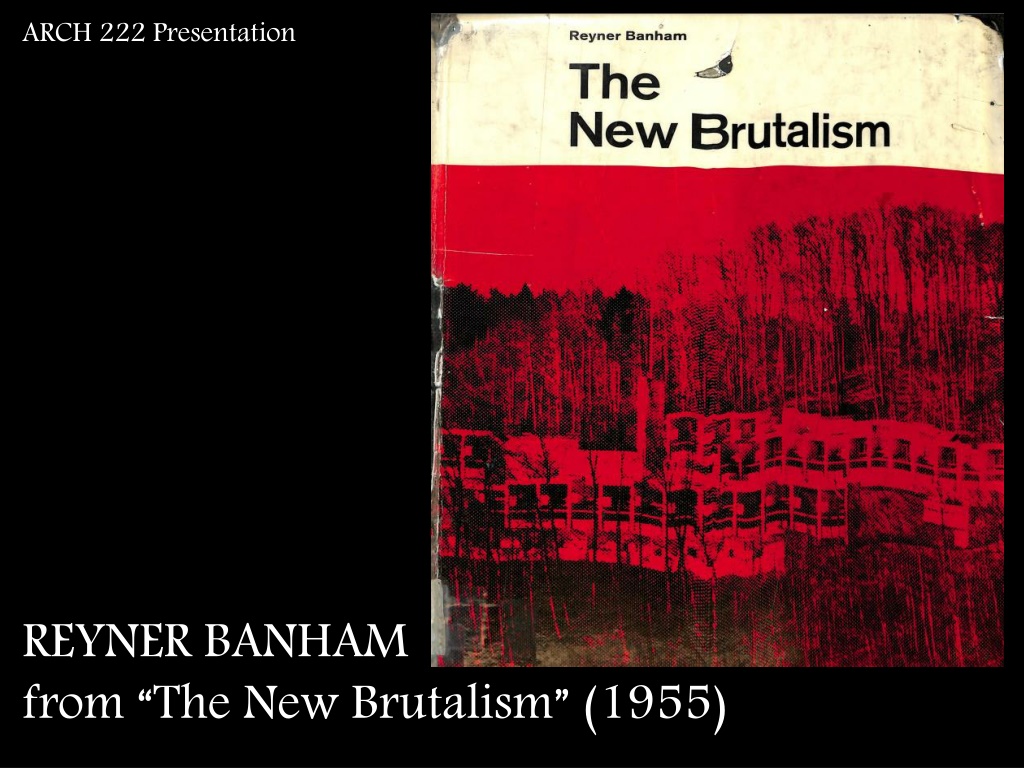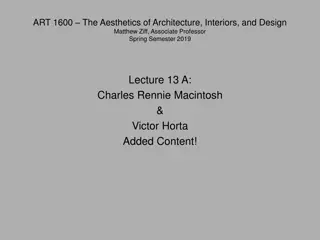Exploring the Essence of Brutalism in Architecture through Reyner Banham's Perspective
Discover the architectural movement of Brutalism through Reyner Banham's insights, exploring its origins, key characteristics, influential architects like Le Corbusier and Peter & Alison Smithson, along with notable Brutalist structures. Banham's definition of Brutalist buildings and the unique features of this style, such as form following function, rough surfaces, precast concrete construction, and its association with Team X, shed light on the significance of Brutalism in the architectural world.
Download Presentation

Please find below an Image/Link to download the presentation.
The content on the website is provided AS IS for your information and personal use only. It may not be sold, licensed, or shared on other websites without obtaining consent from the author. Download presentation by click this link. If you encounter any issues during the download, it is possible that the publisher has removed the file from their server.
E N D
Presentation Transcript
ARCH 222 Presentation REYNER BANHAM from The New Brutalism (1955)
CONTEXT The New Brutalism by Reyner Banham Reyner Banham What is the Brutalism? Characteristics of brutalism Leading Brutalism I. Le Corbusier Mies Van Der Rohe II. Peter & Alison Smithson III. Paul Rudolph IV. Louis Kahn Critism
PETER REYNER BANHAM He (2 March 1922 19 March 1988) was one of the most influential writers on architecture, design, and popular culture from the mid- 1950s to the late 1980s.
BRUTALISM BRUTALISM Brutalism is an architectural style that spawned from the modernist architectural movement and which flourished from the 1950s to the 1970s. Brutalist building typically contains poured concrete, and also include brick, glass and steel.
Banham defined Brutalist buildings as being 1. Formal legibility of a plan 2. Clear exhibition of Structure 3. Valuation of Materials as found. Boston City Hall The term Brutalism derived from the French phrase buton brute which a phrase Used by Le Corbusier. J. Edgar Hoover Building in Washington, D.C. Orange County Government Center Paul Rudolph
CHARACTERISTICS Characteristics of Brutalism Form follow function. Rough and unfinished surface. Precast concrete construction. Low cost construction. Quickly and economically constructed. Massive shapes and sculptures. Brick work and stone.
Leading Brutalist Architects associated with the brutalist style include; Le Corbusier Peter & Alison Smithson Paul Radolph Louis Kahn Team X (10) Team X", was a group of architects and other invited participants who assembled starting in July 1953 at the 9th Congress of C.I.A.M Two different movements emerged from Team 10: the New Brutalism of the English members and the Structuralism of the Dutch members.
LE CORBUSIER He was a Swiss-French architect, designer, painter,urban planner, writer, and one of the pioneers of what is now called modern architecture. He was born in Switzerland and became a French citizen in 1930.
Unite dHabitation The building is constructed in beton brut ( rough- cast concrete) Unite d'habitation (Housing Unit) is the name of a modernist residential housing design principle developed by Le Corbusier.
Illinois Institute of Technology, Chicago Widely regarded as Mies van der Rohe's masterpiece, Crown Hall, completed in 1956 Basic steel and glass construction style
PETER AND ALISON SMTHSON English architects Alison Smithson and Peter Smithson together formed an architectural partnership, and are often associated with the New Brutalism.
Robin Hood Gardens Robin Hood Gardens is a residential estate in Poplar, London designed in the late 1960s by architects Alison and Peter Smithson. Highly visible examples of Brutalist architecture. streets in the sky
PAUL RUDOLPH Paul Marvin Rudolph was born October 23, 1918 in Elkton, Kentucky. He was an American architect. He was known for his contributions to modernism throughout the latter half of the 20th century.
Art and Architecture Building, Yale University Completed in 1963 Concrete and glass
LOUIS KAHN Louis Isadore Kahn was born in 1901. The American architect Louis Kahn (1901- 1974) is regarded as one of the great master builders of the twentieth century
Yale University Art Gallery, in New Haven In this structure, Kahn typically tended toward heavily textured brick and bare concrete, which he wonderfully juxtaposes against more refined and pristine surfaces, like the large glass windows of this building beautifully lined by steel.
JATIYO SANGSHAD BHABAN ( National Parliament House) Large areas of blank wall. Reinforced concrete structures. Strong bold shapes.
Critism of the Brutalism Much of the criticism comes not only from the designs of the buildings, but also from the fact that concrete fa ades do not age well in damp, cloudy maritime climates such as those of northwestern Europe. In these climates, the concrete becomes streaked with water stains and sometimes with moss and lichens, and rust leaches from the steel reinforcing bars.























